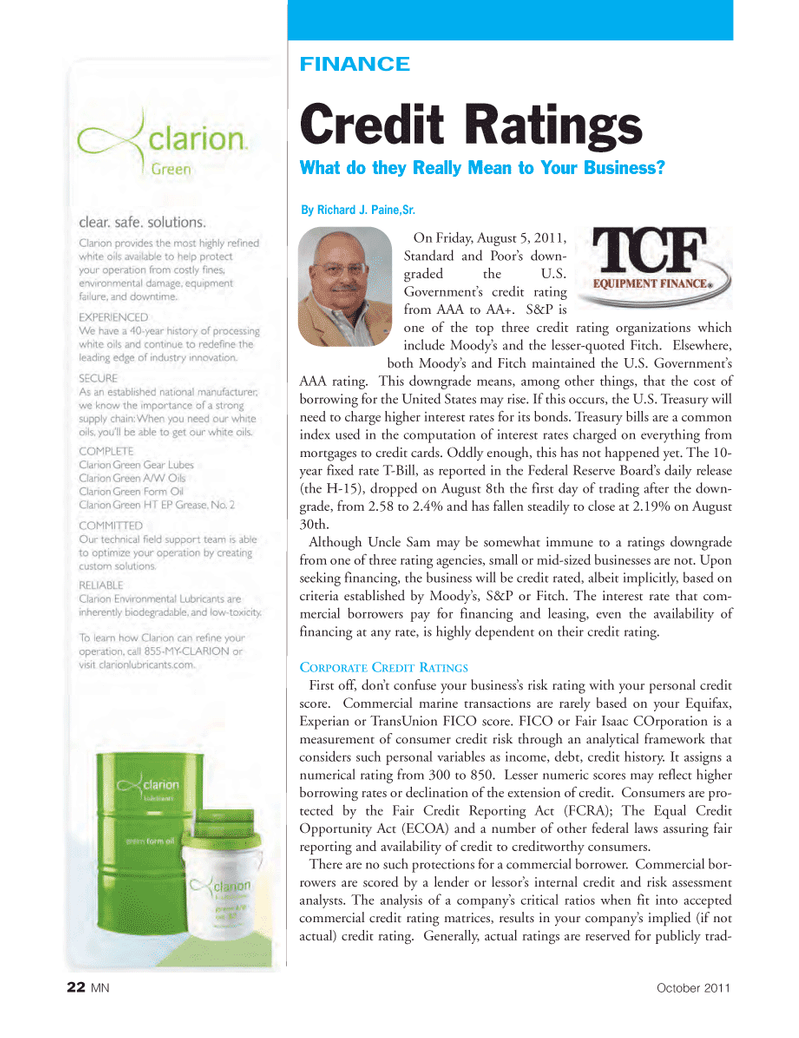
Page 22: of Marine News Magazine (October 2011)
The Yearbook
Read this page in Pdf, Flash or Html5 edition of October 2011 Marine News Magazine
FINANCEOn Friday, August 5, 2011, Standard and Poor?s down- graded the U.S.Government?s credit rating from AAA to AA+. S&P is one of the top three credit rating organizations which include Moody?s and the lesser-quoted Fitch. Elsewhere, both Moody?s and Fitch maintained the U.S. Government?s AAA rating. This downgrade means, among other things, that the cost of borrowing for the United States may rise. If this occurs, the U.S. Treasury will need to charge higher interest rates for its bonds. Treasury bills are a common index used in the computation of interest rates charged on everything from mortgages to credit cards. Oddly enough, this has not happened yet. The 10- year fixed rate T-Bill, as reported in the Federal Reserve Board?s daily release (the H-15), dropped on August 8th the first day of trading after the down- grade, from 2.58 to 2.4% and has fallen steadily to close at 2.19% on August 30th. Although Uncle Sam may be somewhat immune to a ratings downgrade from one of three rating agencies, small or mid-sized businesses are not. Upon seeking financing, the business will be credit rated, albeit implicitly, based on criteria established by Moody?s, S&P or Fitch. The interest rate that com- mercial borrowers pay for financing and leasing, even the availability of financing at any rate, is highly dependent on their credit rating. CORPORATE CREDITRATINGS First off, don?t confuse your business?s risk rating with your personal credit score. Commercial marine transactions are rarely based on your Equifax, Experian or TransUnion FICO score. FICO or Fair Isaac COrporation is a measurement of consumer credit risk through an analytical framework that considers such personal variables as income, debt, credit history. It assigns a numerical rating from 300 to 850. Lesser numeric scores may reflect higher borrowing rates or declination of the extension of credit. Consumers are pro- tected by the Fair Credit Reporting Act (FCRA); The Equal Credit Opportunity Act (ECOA) and a number of other federal laws assuring fair reporting and availability of credit to creditworthy consumers. There are no such protections for a commercial borrower. Commercial bor- rowers are scored by a lender or lessor?s internal credit and risk assessment analysts. The analysis of a company?s critical ratios when fit into accepted commercial credit rating matrices, results in your company?s implied (if not actual) credit rating. Generally, actual ratings are reserved for publicly trad- Credit Ratings What do they Really Mean to Your Business? 22MNOctober 2011By Richard J. Paine,Sr. MN#10 (18-31):MN 2011 Layouts 10/5/2011 11:13 AM Page 22

 21
21

 23
23
